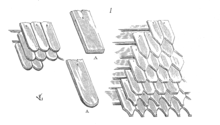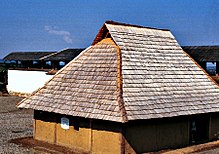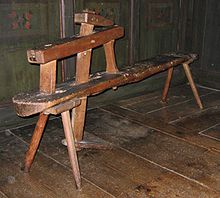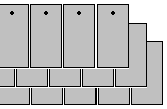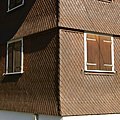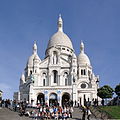shingle
Shingles are a product for roofing, regionally also for facade cladding.
Shingles are originally made of wood , hence wood shingles . Colloquially, similarly shaped and appropriately used products made of aluminum , bitumen , granite , fiber cement , copper , stone, slate or clay are also referred to as 'shingles' - technically today they are called roof tiles or roof stones if they are used to cover the roof, and facade panels if they are used serve as wall formwork. The wood shingle covering of the roof is one of the soft roofs , the substitute materials mentioned are among the hard roofs .
etymology
The German loan word scindula 'Schindel' to scindere 'splits' comes from the Latin language . From a translation of the Bible by Wulfila from the Visigothic period (middle of the 4th century) there is evidence of the name Skalja 'shingle' ( old north. Skilja 'split, separate') for a roof covered with skildus (Gothic name for 'board').
history
Shingles are an ancient form of roofing . Excavations have shown that people also used wood as a building material many thousands of years ago - to erect tents and huts. Using tree bark (birch, spruce, etc.), fur , clay , brushwood , straw and reeds, he shielded the roofs and walls of the dwellings from wind and cold, laid out like scales on the roof structure so that water could not penetrate the interior.
In pre-Antiquity, flat stone slabs or wooden shingles were used, depending on the region. The wood shingle is widespread in the entire northern and central latitudes of the Old World, but East Asia occupies a special position, where bamboo is a natural material ideally suited for roofing. There were also shingles made of clay (which the Romans called scandula , today they are called beaver tail tiles ). Shingles were also made from slate because of its good cleavability and durability. Roof tiles and facade panels made of these materials such as bitumen, cement fiber (Eternit) and those made of aluminum have largely replaced the wood shingles in the 20th century, but in the context of sustainable building and modern wood architecture, they are once again being used more widely .
antiquity
An example from the Iron Age shows the manor house of the Heuneburg near Hundersingen (Baden-Württemberg). At that time the shingles were partly attached with wooden nails and partly tied with leather straps. The oldest shingle to date was found during the excavations of the Buchau moated castle near Bad Buchau (Baden-Württemberg), an approx. 3000 years old (approx. 950 BC) split oak shingle that was preserved in the moor. At around the same time, split silver fir shingles were used in Zug-Sumpf (Switzerland). In a project funded by the European Union, part of the facility has been reconstructed in recent years.
Roman age
Cornelius Nepos assured that Rome was covered with shingles for 470 years up to the time of King Pyrrhus (around 275 BC) - at least one differentiated city districts according to forest names. Pliny and Tacitus already reported that Germanic peoples had clapboard wooden houses . During excavations in the Roman fort in Saalburg in Hesse, a log or shingle pick and round oak shingles have been found.
middle Ages
Until the early Middle Ages, the wood shingle was the most widely used roofing material in almost all of Europe. Up until the Carolingian era , clapboard roofs were common practice even on elegant buildings. In simple houses and in areas with little wood, locally available materials such as thatch (reeds) were used. Some medieval churches - especially in southern Europe - were covered with flat stone slabs (French: lauzes ). In the far north, artfully laid wooden shingles have protected the stave churches built with carpentry for centuries .
Modern times
Soft roofs were still the predominant form of roofing in Germany in the 18th century. One reason for the decline in the shingle roof was the risk of fire. In the cities that were getting bigger and bigger, bigger fires started more and more often due to insufficient extinguishing possibilities and close development. This led to a regional ban on the shingle roof. As a result of the shortage of wood during the Little Ice Age , the shingle roof was increasingly displaced by that of brick and slate.
Meaning today
In wooded and higher-lying areas, the shingle roof has persisted in individual residential and farmhouses to this day, and wall shingling has also remained predominant in the region ( Vorarlberg , western Switzerland). The leg shingle roof is still widespread in the Alps because of its special charisma. Around 1987, around 10,000 shingle roofs were suspected in South Tyrol . Nevertheless, the traditional shingle roof was largely pushed into the area of churches and museums in the course of the 20th century.
Since the 1980s, wood shingling has been used more again due to concepts that strive for ecology and sustainability , as well as the introduction of machine-produced shingles and the use of non-European, particularly resistant woods. In addition, there is a noticeable architectural trend called New Alpine Architecture , which seeks to combine the findings of building and material research and modern design language with the traditionally local architectural styles. Timber construction in particular is gaining in importance again.
In the stormy coastal areas, the wood clapboard has proven itself on churches and windmills.
Manufacturing, shapes and materials

The original form, the leg shingles, were weighted down with stones, today shingles are generally nailed. Shingles are only covered, grooved shingles are also used in the Ore Mountains and Bohemian Forest .
To get the final grayish tone of the fresh, yellowish shingles faster, they were occasionally dipped in buttermilk before assembly.
There are two types of shingle, which differ in their production: the saw or board and the split shingle .
Split clapboard
Splitting does not destroy the natural grain of the wood, which makes the split shingle more durable than a sawn one.
Split shingles are made by the Schindler by splitting a raw shingle from the block, either hydraulically or conventionally with a shingle knife (Kletzhacke) and mallet . The wood is selected straight and fine-growing , as well as knot-free , whereupon it is cut to length, split and reworked with a wide knife that has a handle on both sides. This knife is also known as a pull knife . In order to be able to hold the raw clapboard for this process, the same instrument was always used in all of Central Europe, the clapboard ( cutting donkey, beeching donkey, Heinzelbank , carving bench , Schnitzelbank, Schindelgoass etc.).
Saw clapboard and clapboard
The other type of shingle is characterized by the destruction of the grain of the wood. A distinction is made between saw shingles and board shingles .
Board shingles can still be found in Carinthia and Styria and from there eastwards to East Asia , in Scandinavia and elsewhere around the world. This roofing is the least durable clapboard and requires the most maintenance.
In contrast to the board shingles, saw shingles in the wall area are common in all types of wood and available in all sizes. The profitability is good despite the lower durability compared to the split clapboard and, above all, its diverse design options offer architects a broad basis for new planning ideas.
Swedish Visthus (Urgammal type ( Nordisk familjebok ))
Detail of a shingle facade in Lech (Vorarlberg)
Woods and durability
As a rule, the locally available tree species were used for shingle production: in northern Germany mainly oak , in the Ore Mountains, Bohemian Forest and Black Forest spruce , in Hesse beech and in the Alpine region primarily larch . For softwood, only trees that are turned to the left are suitable so that the wood twists evenly after processing and retains its shape. When wet, the wood stretches due to its natural internal tension and lies flat on the roof, while drying, however, it rotates slightly, and gaps appear, which facilitate drying. Thanks to this “pine cone effect” and the fact that board and split shingles never lie flat on top of each other, an optimal lifespan has been achieved for the otherwise weather-prone wood.
In the past, split shingles made of spruce or larch wood could have a shelf life of 30–40 years or 50–70 years. However, this is no longer realistic today for various reasons (poorer wood, environment, different roof constructions, etc.). Today the durability of spruce and larch in the roof area is between 12 and 25 years, a longer durability of domestic woods is only possible with impregnation; or you can switch to more durable woods like that of the giant tree of life ( Thuja plicata ) and the Canadian Alaskan cedar ( Chamaecyparis nootkatensis ). Split shingles are still made from oak in small quantities in the monument protection area and from chestnut (western Switzerland, French Alps). Aspen is widely used in northern Eastern Europe .
Saw shingles as roofing only make sense with particularly durable types of wood. In Germany, there is a test certificate for hard roofing in accordance with DIN 4102 Part 7 - this means that saw shingles made from Alaskan cedar are classified as fire- resistant as a tile roof .
The lace house in Fritzlar - facade partially clad with sawn oak shingles
Moss growth, the hygroscopic properties of which generally have a negative effect on the service life
Types of coverage
With regard to the way in which the roof is covered, a distinction is made between Scharschinge roofs and Legshingle roofs .
Sharp shingle roof
The shingle roof is suitable for steeply sloping roofs. The shingles are doing, generally with three-time coverage , a batten nailed. Double coverage is also possible for low-value buildings.
Doubled single cover, Valley Forge, Chester County, Pennsylvania (reconstruction)
Legshingle roof
The leg shingle roof is used for flat roof slopes. The shingles also cover each other three, sometimes four times, but are simply laid on top. They are secured by heavy stones , on drill collars rest and the shingles on the roof back up (a Legschindeldach is therefore in some regions as Schwardach referred, in the Allgäu and the Black Forest are Legschindeln also referred to as countries known). The shingle roof must be covered about every five years, with one side of the shingle that has not yet been exposed to the weather facing up. So the shingles can be used at least four times.
Clapboard covering, Lachung , Sikkim
German Tibet Expedition Ernst Schäfer (1938/39)Speicher, Gluringen , Valais, Switzerland
More pictures
Detail view of the wooden clapboard of the Sehestedt Church (1960s)
Imitation clapboard
Particularly in the south-west of France ( Charente ), smaller shingle roofs were reproduced in stone as early as the Middle Ages, whereby not every single shingle was always imitated, but often only the shape of the overlap of the shingle layers was in the foreground. Paul Abadie , who led the restoration of the Saint-Frond cathedral in Périgueux and later received the contract for the new building of the Sacré-Cœur de Montmartre in Paris, had been active in this region since 1844 - he provided the domes of both buildings with clapboard imitations. Since the second half of the 20th century, imitations of shingles made of various plastics have also been available in building materials stores.
Church of Our Lady in Berneuil (Charente)
Sacré-Cœur de Montmartre in Paris
See also
literature
- Jens Carstensen: Shingle roof and shingle gable: historical development. Manufacture and use of the wood shingle. New edition: Edition libri rari, Schäfer, 1992, ISBN 978-3-88746-284-0
Web links
- http://www.safierstaelle.ch/ Association in the Alps - protection of historical buildings with shingle roofing
Individual evidence
- ↑ Bruce Clouette and Maura Cronin: National Register of Historic Places Inventory-Nomination: Fenwick Historic District . National Park Service. April 19, 1994.
- ↑ In Austrian, the activity of splitting is called klieben , the job title Bretterklieber is still common there as a family name.
- ↑ Jens Carstensen: The wood shingle: its historical development, production and use mainly shown using examples from the Jizera, Giant and Ore Mountains . Dresden 1937.
- ↑ black roof. (No longer available online.) In: Lexikon. Austrian open-air museum Stübing , formerly in the original ; Retrieved November 2, 2009 . ( Page no longer available , search in web archives ) Info: The link was automatically marked as defective. Please check the link according to the instructions and then remove this notice.
- ↑ http://www.das-baulexikon.de/lexikon/Legschindel.htm
